dashboard RENAULT TWINGO 2012 2.G Owners Manual
[x] Cancel search | Manufacturer: RENAULT, Model Year: 2012, Model line: TWINGO, Model: RENAULT TWINGO 2012 2.GPages: 220, PDF Size: 6.73 MB
Page 26 of 220
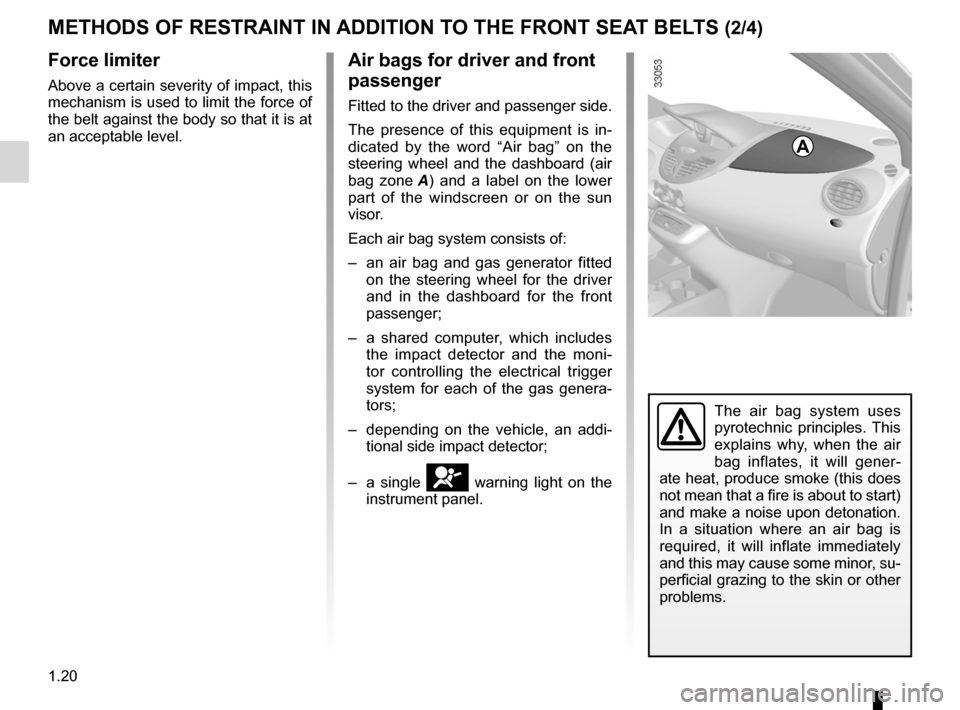
1.20
ENG_UD24708_5
Dispositifs complémentaires à la ceinture avant (X44 - Renault)
ENG_NU_952-4_X44_Renault_1
Jaune NoirNoir texte
METhODs OF REsTRAINT IN ADDITION TO ThE FRONT sEAT BELTs (2/4)
Force limiter
Above a certain severity of impact, this
mechanism is used to limit the force of
the belt against the body so that it is at
an acceptable level.
Air bags for driver and front
passenger
Fitted to the driver and passenger side.
The presence of this equipment is in -
dicated by the word “Air bag” on the
steering wheel and the dashboard (air
bag zone A ) and a label on the lower
part of the windscreen or on the sun
visor.
Each air bag system consists of:
– an air bag and gas generator fitted
on the steering wheel for the driver
and in the dashboard for the front
passenger;
– a shared computer, which includes
the impact detector and the moni -
tor controlling the electrical trigger
system for each of the gas genera -
tors;
– depending on the vehicle, an addi -
tional side impact detector;
– a single
å warning light on the
instrument panel.
The air bag system uses
pyrotechnic principles. This
explains why, when the air
bag inflates, it will gener -
ate heat, produce smoke (this does
not mean that a fire is about to start)
and make a noise upon detonation.
In a situation where an air bag is
required, it will inflate immediately
and this may cause some minor, su-
perficial grazing to the skin or other
problems.
A
Page 27 of 220
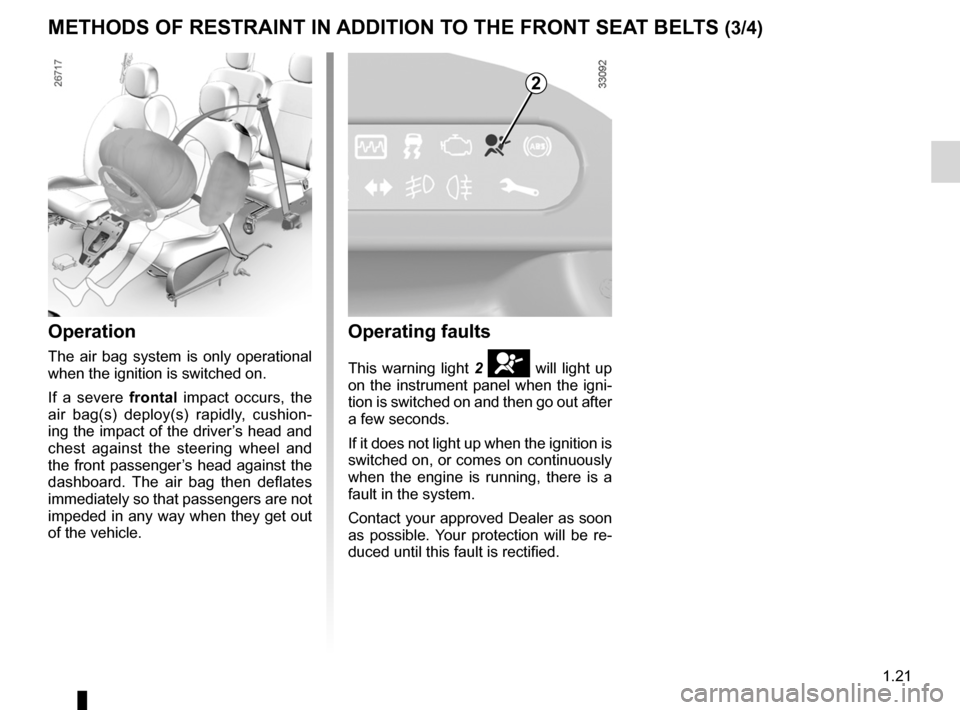
JauneNoirNoir texte
1.21
ENG_UD24708_5
Dispositifs complémentaires à la ceinture avant (X44 - Renault)
ENG_NU_952-4_X44_Renault_1
METhODs OF REsTRAINT IN ADDITION TO ThE FRONT sEAT BELTs (3/4)
Operation
The air bag system is only operational
when the ignition is switched on.
If a severe frontal impact occurs, the
air bag(s) deploy(s) rapidly, cushion -
ing the impact of the driver’s head and
chest against the steering wheel and
the front passenger’s head against the
dashboard. The air bag then deflates
immediately so that passengers are not
impeded in any way when they get out
of the vehicle.
Operating faults
This warning light 2 å will light up
on the instrument panel when the igni -
tion is switched on and then go out after
a few seconds.
If it does not light up when the ignition is
switched on, or comes on continuously
when the engine is running, there is a
fault in the system.
Contact your approved Dealer as soon
as possible. Your protection will be re-
duced until this fault is rectified.
2
Page 28 of 220

1.22
ENG_UD24708_5
Dispositifs complémentaires à la ceinture avant (X44 - Renault)
ENG_NU_952-4_X44_Renault_1
METhODs OF REsTRAINT IN ADDITION TO ThE FRONT sEAT BELTs (4/4)
All of the warnings below are given so that the air bag is not obstructed in any way when it is deployed and also to pre-
vent the risk of serious injuries caused by items which may be dislodged\
when the air bag deploys.
Warnings concerning the driver’s air bag
– Do not modify the steering wheel or the steering wheel boss.
– Do not cover the steering wheel boss under any circumstances.
– Do not attach any objects (badge, logo, clock, telephone holder, etc.) to the steering wheel boss.
– The steering wheel must not be removed (except by qualified personnel from our Network).
– When driving, do not sit too close to the steering wheel. Sit with your arms slightly bent (see the information on “Adjusting
your driving position” in Section 1). This will allow sufficient space for the air bag to deploy correctly and be fully effective.
Warnings concerning the passenger air bag
– Do not attach or glue any objects (badge, logo, clock, telephone holder, etc.) to the dashboard on or near the air bag.
– Do not place anything between the dashboard and the passenger (pet, umbrella, walking stick, parcels, etc.).
– The passenger must not put his or her feet on the dashboard or seat as there is a risk that serious injuries may occur. In
general, parts of the body should be kept away from the dashboard (knee\
s, hands, head, etc.).
– The systems in addition to the front passenger seat belt should be reactivated as soon as a child seat is removed, to ensure
the protection of the passenger in the event of an impact.
A REAR-FACING ChILD sEAT MUsT NOT BE FITTED TO ThE FRONT p AssENGER sEAT UNLEss
ThE ADDITIONAL REsTRAINT sYsTEMs, I.E. ThE p AssENGER AIR BAG, ARE DEACTIVATED.
(Refer to Section 1 “Child safety: deactivating/activating the front\
passenger air bag”).
Page 43 of 220
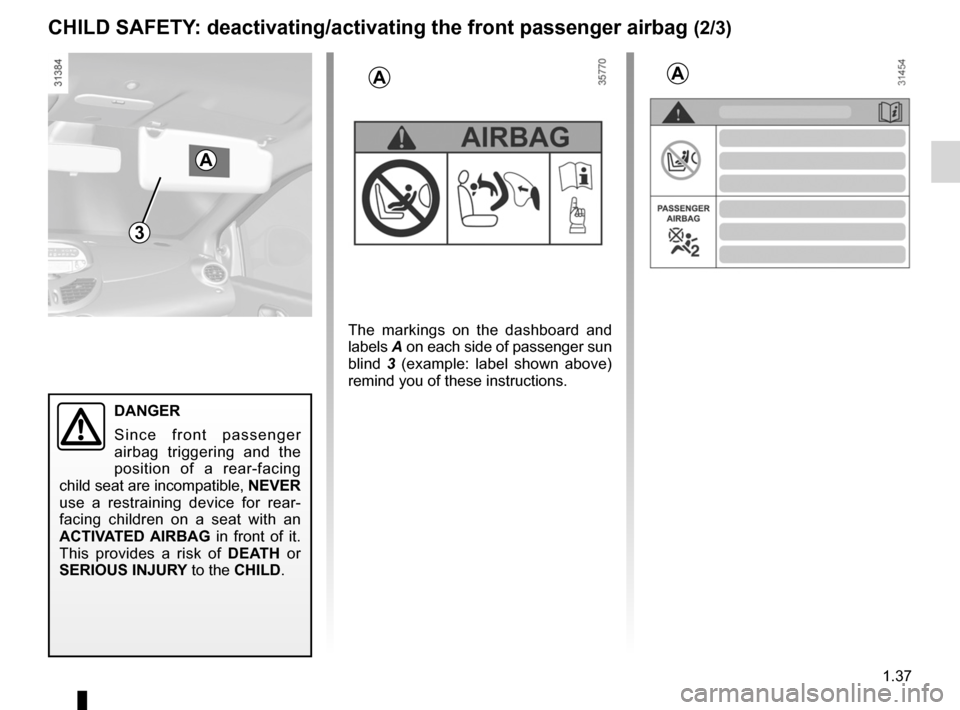
JauneNoirNoir texte
1.37
ENG_UD29224_6
sécurité enfants : désactivation/activation airbag (X44 - Rena\
ult)
ENG_NU_952-4_X44_Renault_1
ChILD sAFETY : deactivating/activating the front passenger airbag (2/3)
DANGER
S i n c e f r o n t p a s s e n g e r
airbag triggering and the
position of a rear-facing
child seat are incompatible, NEVER
use a restraining device for rear -
facing children on a seat with an
ACTIVATED AIRBAG in front of it.
This provides a risk of DEATh or
sERIOUs INJURY to the ChILD.
The markings on the dashboard and
labels A on each side of passenger sun
blind 3 (example: label shown above)
remind you of these instructions.
3
AA
A
Page 102 of 220
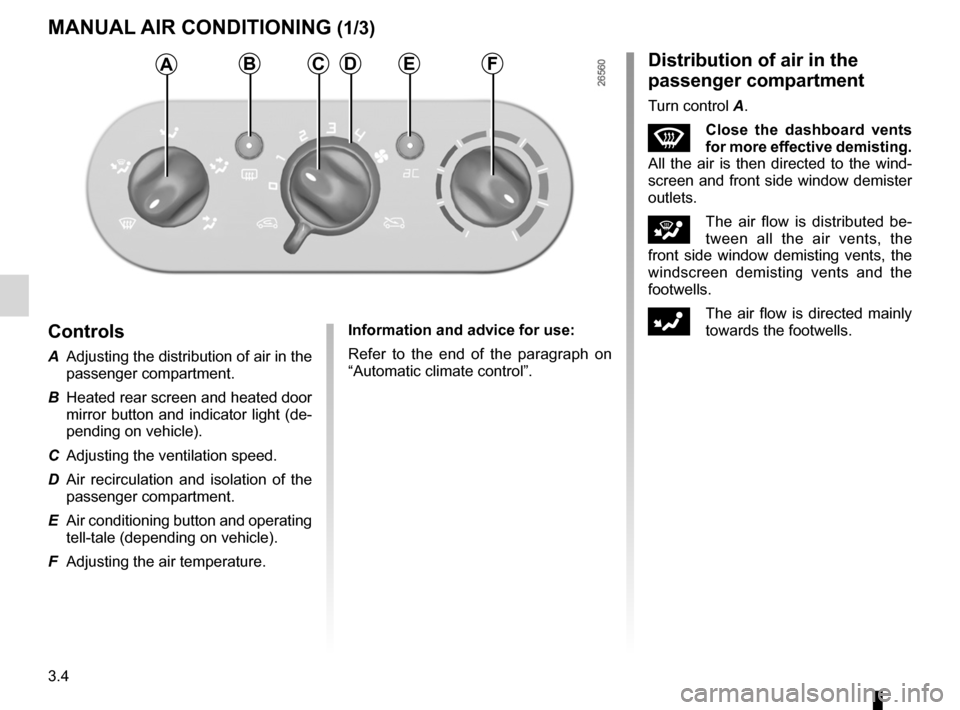
heating system ..................................... (up to the end of the DU)
ventilation ............................................. (up to the end of the DU)
3.4
ENG_UD20165_4
Chauffage - Ventilation avec isolation de l habitacle (X44 - Renault)
ENG_NU_952-4_X44_Renault_3
Jaune NoirNoir texte
Manual air conditioning
MANuAl AIR CoNDITIoNINg (1/3)
Controls
A Adjusting the distribution of air in the
passenger compartment.
B Heated rear screen and heated door
mirror button and indicator light (de-
pending on vehicle).
C Adjusting the ventilation speed.
D Air recirculation and isolation of the
passenger compartment.
E Air conditioning button and operating
tell-tale (depending on vehicle).
F Adjusting the air temperature.
Information and advice for use:
Refer to the end of the paragraph on
“Automatic climate control”.
Distribution of air in the
passenger compartment
Turn control A.
WClose the dashboard vents
for more effective demisting.
All the air is then directed to the wind -
screen and front side window demister
outlets.
iThe air flow is distributed be -
tween all the air vents, the
front side window demisting vents, the
windscreen demisting vents and the
footwells.
FThe air flow is directed mainly
towards the footwells.
ABCEFD
Page 103 of 220
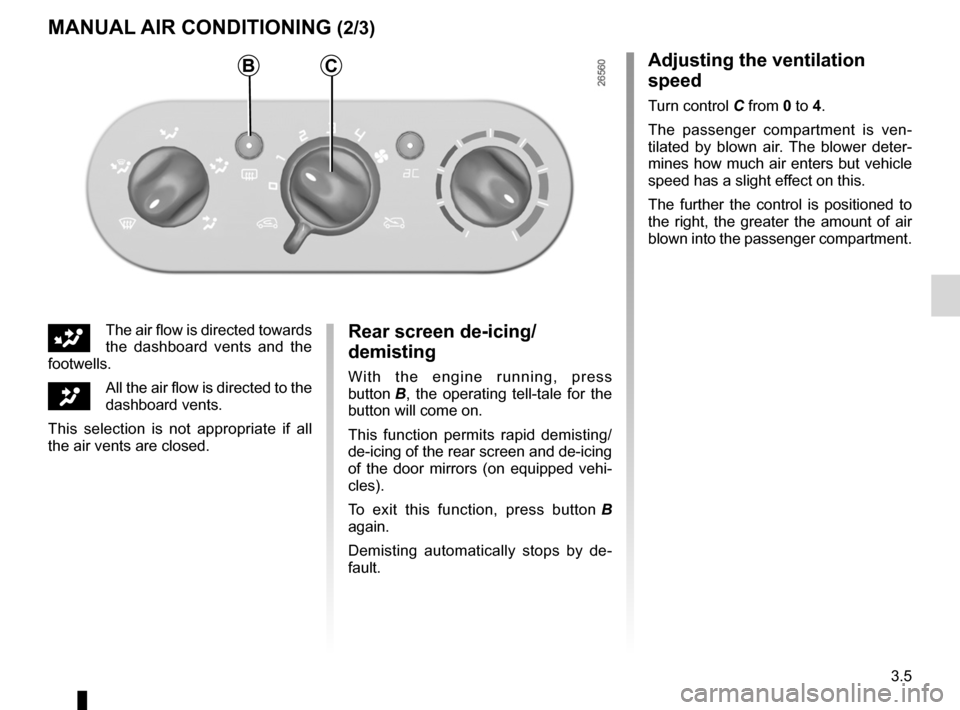
demistingrear screen ....................................................... (current page)
rear screen demisting ......................................................... (current page)
JauneNoirNoir texte
3.5
ENG_UD20165_4
Chauffage - Ventilation avec isolation de l habitacle (X44 - Renault)
ENG_NU_952-4_X44_Renault_3
GThe air flow is directed towards
the dashboard vents and the
footwells.
JAll the air flow is directed to the
dashboard vents.
This selection is not appropriate if all
the air vents are closed.
Rear screen de-icing/
demisting
W i t h t h e e n g i n e r u n n i n g , p r e s s
button B , the operating tell-tale for the
button will come on.
This function permits rapid demisting/
de-icing of the rear screen and de-icing
of the door mirrors (on equipped vehi -
cles).
To exit this function, press button B
again.
Demisting automatically stops by de -
fault.
Adjusting the ventilation
speed
Turn control C from 0 to 4.
The passenger compartment is ven -
tilated by blown air. The blower deter -
mines how much air enters but vehicle
speed has a slight effect on this.
The further the control is positioned to
the right, the greater the amount of air
blown into the passenger compartment.
BC
MANuAl AIR CoNDITIoNINg (2/3)
Page 123 of 220
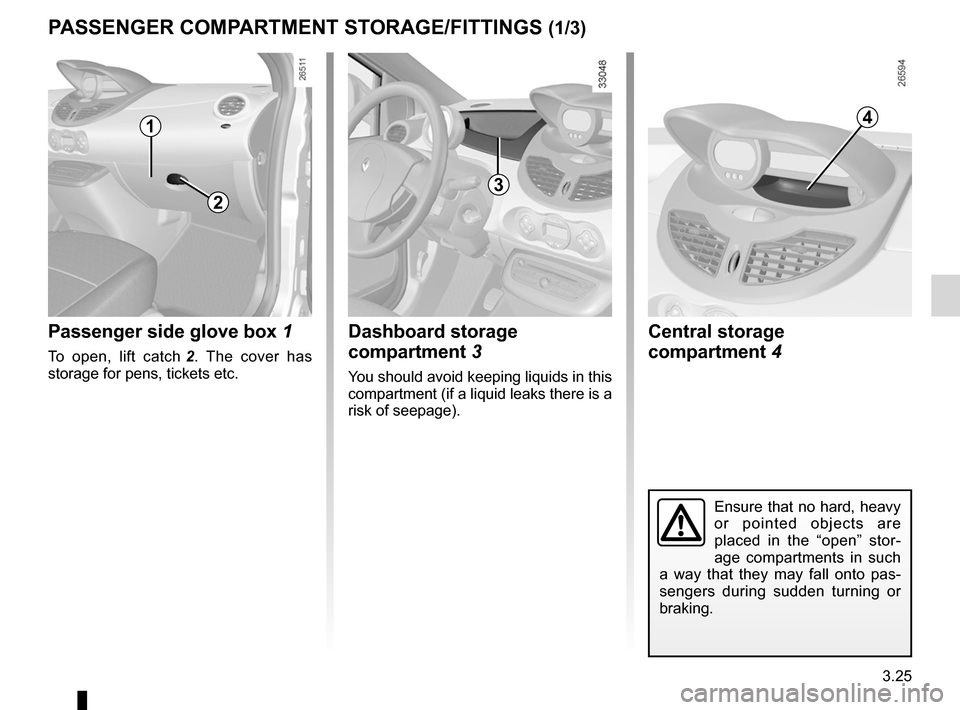
storage compartments .......................... (up to the end of the DU)
storage compartment ............................(up to the end of the DU)
3.25
ENG_UD24510_5
Rangements / Aménagements de l habitacle (X44 - Renault)
ENG_NU_952-4_X44_Renault_3
Passenger compartment storage space and fittings
PASSENgER CoMPARTMENT ST oRAgE/FITTINgS (1/3)
Passenger side glove box 1
To open, lift catch 2 . The cover has
storage for pens, tickets etc.
Dashboard storage
compartment 3
You should avoid keeping liquids in this
compartment (if a liquid leaks there is a
risk of seepage).
Central storage
compartment 4
Ensure that no hard, heavy
or pointed objects are
placed in the “open” stor -
age compartments in such
a way that they may fall onto pas -
sengers during sudden turning or
braking.
2
1
3
4
Page 154 of 220
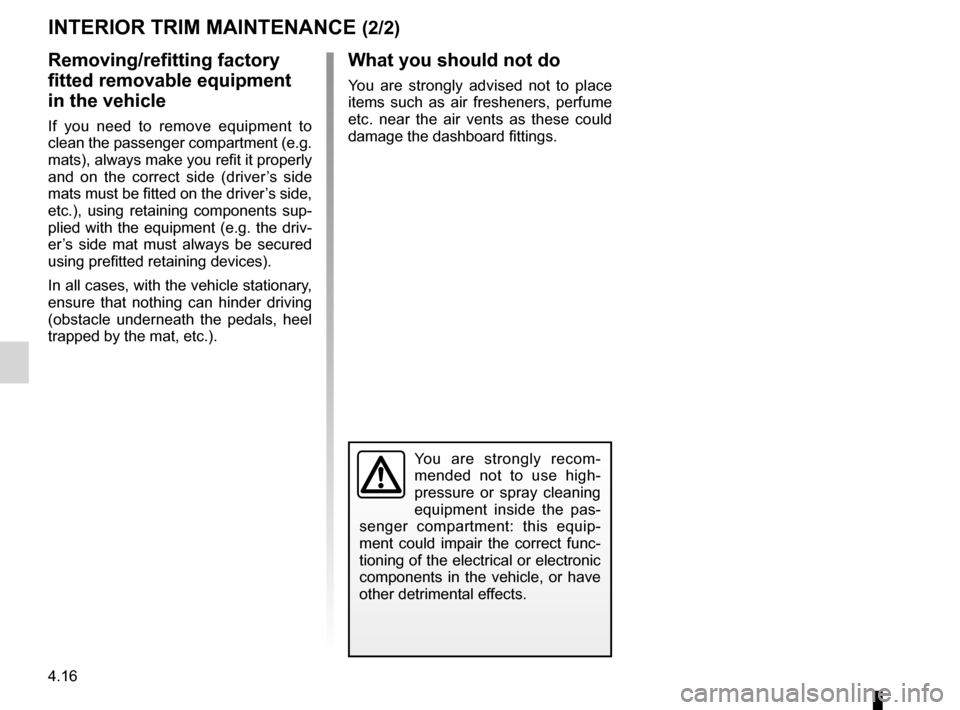
4.16
ENG_UD22508_5
Entretien des garnitures intérieures (X44 - Renault)
ENG_NU_952-4_X44_Renault_4
INTERIOR TRIM MAINTENANCE (2/2)
Removing/refitting factory
fitted removable equipment
in the vehicle
If you need to remove equipment to
clean the passenger compartment (e.g.
mats), always make you refit it properly
and on the correct side (driver’s side
mats must be fitted on the driver’s side,
etc.), using retaining components sup-
plied with the equipment (e.g. the driv-
er’s side mat must always be secured
using prefitted retaining devices).
In all cases, with the vehicle stationary,
ensure that nothing can hinder driving
(obstacle underneath the pedals, heel
trapped by the mat, etc.).
What you should not do
You are strongly advised not to place
items such as air fresheners, perfume
etc. near the air vents as these could
damage the dashboard fittings.
You are strongly recom -
mended not to use high -
pressure or spray cleaning
equipment inside the pas -
senger compartment: this equip -
ment could impair the correct func-
tioning of the electrical or electronic
components in the vehicle, or have
other detrimental effects.
Page 159 of 220
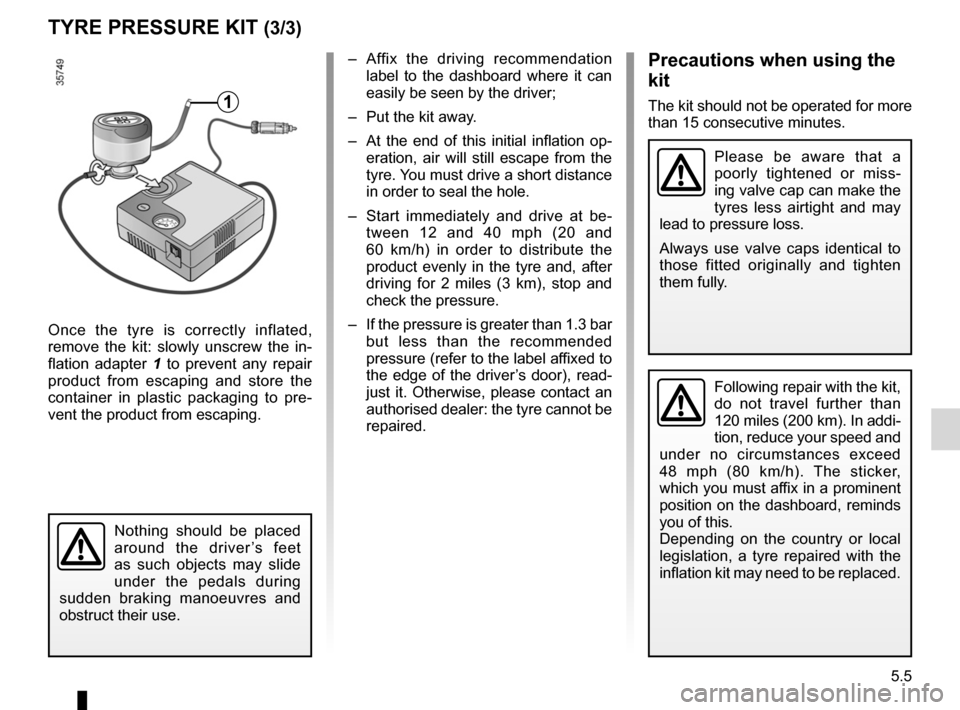
JauneNoirNoir texte
5.5
ENG_UD28665_3
Kit de gonflage des pneumatiques (X77 - X85 - B85 - C85 - S85 - X77 ph2\
- K85 - X95 - E95 - X67 - X92 - X10 - X98 - X52 - Renault)
ENG_NU_952-4_X44_Renault_5
tYre PreSSure KIt (3/3)
Once the tyre is correctly inflated,
remove the kit: slowly unscrew the in -
flation adapter 1 to prevent any repair
product from escaping and store the
container in plastic packaging to pre -
vent the product from escaping.
– Affix the driving recommendation
label to the dashboard where it can
easily be seen by the driver;
– Put the kit away.
– At the end of this initial inflation op-
eration, air will still escape from the
tyre. You must drive a short distance
in order to seal the hole.
– Start immediately and drive at be -
tween 12 and 40 mph (20 and
60 km/h) in order to distribute the
product evenly in the tyre and, after
driving for 2 miles (3 km), stop and
check the pressure.
– If the pressure is greater than 1.3 bar
but less than the recommended
pressure (refer to the label affixed to
the edge of the driver’s door), read-
just it. Otherwise, please contact an
authorised dealer: the tyre cannot be
repaired.Precautions when using the
kit
The kit should not be operated for more
than 15 consecutive minutes.
Nothing should be placed
around the driver ’s feet
as such objects may slide
under the pedals during
sudden braking manoeuvres and
obstruct their use.
1
Please be aware that a
poorly tightened or miss -
ing valve cap can make the
tyres less airtight and may
lead to pressure loss.
Always use valve caps identical to
those fitted originally and tighten
them fully.
Following repair with the kit,
do not travel further than
120 miles (200 km). In addi -
tion, reduce your speed and
under no circumstances exceed
48 mph (80 km/h). The sticker,
which you must affix in a prominent
position on the dashboard, reminds
you of this.
Depending on the country or local
legislation, a tyre repaired with the
inflation kit may need to be replaced.